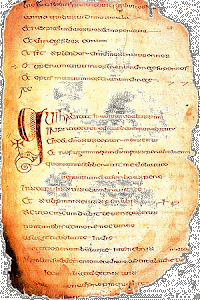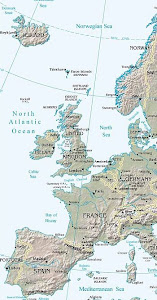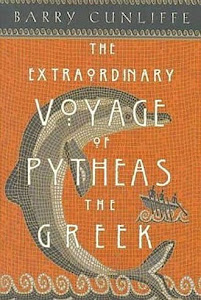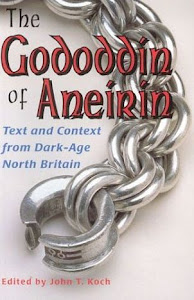For instance, we have a news story that a new academic text (Prof Rachel Elior's Memory And Oblivion: The Secret Of The Dead Sea Scrolls) shows that the Essenes sect, supposedly the first Christians, and authors of the Dead Sea Scrolls, never existed – even though the book isn't even out yet. And there are also news stories, serving whatever end, on some long-running controversy. This year, it’s business as usual.
 Thus, we had National Geographic announcing that the Druids practised human sacrifice – and cannibalism. In case you only remember National Geographic for those glossy full-colour travel magazines with the yellow trimming and earnest photo-essays on remote parts of the world, they now have their own TV channel where they run speculative documentaries. Their announcement is PR for a new NG documentary (with re-enactments), Secrets Of The Druids. The idea is that those Druids-burnt-people-in-giant-wicker-men stories were not just the Romans’ self-serving propaganda, there’s now archaeological evidence, in the form of the mummified ‘bog body’ known as Lindow Man, and some skeletons in a cave near Bristol. In fact Lindow Man was dug up out the peat in 1981, and Celtic scholar Dr Anne Ross wrote a book about him in 1991 (Life And Death Of A Druid Prince) theorizing (if memory serves) he was a Druid who agreed to be sacrificed to protect the land. (He died a ritual ‘threefold’ death, and mistletoe pollen was found in his stomach).
Thus, we had National Geographic announcing that the Druids practised human sacrifice – and cannibalism. In case you only remember National Geographic for those glossy full-colour travel magazines with the yellow trimming and earnest photo-essays on remote parts of the world, they now have their own TV channel where they run speculative documentaries. Their announcement is PR for a new NG documentary (with re-enactments), Secrets Of The Druids. The idea is that those Druids-burnt-people-in-giant-wicker-men stories were not just the Romans’ self-serving propaganda, there’s now archaeological evidence, in the form of the mummified ‘bog body’ known as Lindow Man, and some skeletons in a cave near Bristol. In fact Lindow Man was dug up out the peat in 1981, and Celtic scholar Dr Anne Ross wrote a book about him in 1991 (Life And Death Of A Druid Prince) theorizing (if memory serves) he was a Druid who agreed to be sacrificed to protect the land. (He died a ritual ‘threefold’ death, and mistletoe pollen was found in his stomach).
It turns out there’s a question mark after the ‘cannibalism’ part as there’s no real evidence in the mass-grave cave find at Alveston north of Bristol (again, this is nothing new, the find dating back to 2000). Burning people and animals in a giant wicker man as Caesar described doesn’t really work as a prelude to a cannibal feast, but there’s a break-mark on one of the cave bones indicating it could have been a ‘Druid’ drinking the bone marrow. The archaeologist cited here turns out to be Dr Mark Horton, and even he is reluctant to back the Druids-were-ritual-cannibals theory, saying perhaps someone was starving. (I say even he, as Dr Horton got his fingers burnt last year over claims he made as archeo advisor in the BBC Bonekickers TV-series fiasco which I’ve written of at length elsewhere.
Easter being a moveable feast, it can run close to St George’s Day (23rd April) if late, or April Fool’s Day if early, so in between you get a sort of press ‘silly season’ (i.e. the press print stories they otherwise wouldn’t). Last year Easter was relatively late, and our ‘Another Busy Post-Modern Easter’ item also covered items in the press inspired by St George’s Day. This year Easter is relatively early so it follows soon after April Fool’s Day, inspiring hoax news stories to do with sacred relics, so that genuine stories (which are normally high on the strangeness index anyway) get confused with April Fool’s hoaxes.
The Sun newspaper (if we can call it that) had one on a London digger-bulldozer driver finding the Staff Of Moses. (They didn’t bother trying to come up with how it came to be buried in east London, just invoked a few dodgy names like archaeologist Dr Henry Jones of Indiana.)
The Vatican, always under PR siege since Dan Brown cast them as the great villain of Christian history, is usually good for an Easter tie-in story. (The Vatican are currently mulling over some sanction against The Da Vinci Code followup film out soon, Angels & Demons.) This year they did not disappoint, though their genuine non-hoax story echoed an April Fool’s hoax story run several years ago. The first week of April, the Vatican’s own newspaper L'Osservatore Romano reported on where the Turin Shroud was held during its ‘missing years’: the Knights Templar had it. This was suspected at first being a hoax partly as it is a (sort-of) confirmation of the thesis in several books going back to 1978. (There’s even a book arguing the KTs actually created the Shroud relic, the image being that of their last grand master, Jacques de Molay – the image being a bit of post-modern irony on the part of KTs, as their master was sort-of crucified by the Church who – well, you get the idea.)
The report said one of their researchers had found clues in the Vatican Archive that the Shroud was taken away by the Templars so that the Cathars wouldn’t get it, as they would’ve destroyed it since they didn’t believe in a corporeal Jesus. (The Catholic Church destroyed the Cathars and their fellow Gnostics the Albigensians, a massive purge mentioned in most of the 'Holy Blood Holy Grail' books I’ve seen, as part of a grand papal conspiracy to suppress evidence of a Royal Bloodline etc. I think The Da Vinci Code also works it in somewhere.)
The Shroud in this new regard was also the controversial and mysterious sacred relic the Templars venerated, i.e. the bearded head they called Baphomet that they were accused at their 1307-10 purge of worshipping. (Earlier accounts have suggested the head was a relic of John The Baptist who lost his head to either Herod or Salome; or a way of worshipping Islam, with Baphomet a version of Mohamet.) The Vatican report said there was a reference to the KTs using the cloth image in a 1287 initiation. This has stirred up more controversy as a fragment of the border of the Shroud was carbon-dated only to the 14th C, leading to press reports it was a ‘mediaeval fake.’ Since then, others have said that the DNA test was of a patched section of the fire-damaged Shroud, and not valid at all. (The Daily Grail news-commentary website, which ran the Templars-had-the-Shroud story as an April Fool’s joke several years, now mentions there is other manuscript evidence for a pre-mediaeval Shroud. ‘A tenth century codex found in the Vatican Library, the Codex Vossianus Latinus quotes a man called Smera in Constantinople in the 8th century as saying that "King Abgar received a cloth on which one can see not only a face but the whole body."’
The Vatican's researcher was in fact mediaeval scholar Dr. Barbara Frale, who found the account, published last year, of the Pope’s post-1307 inquiry into the Templar accusations, known as the Chinon Parchment. (It was found in 2003 - again there was a time lag, presumably allowing for 5 years to study the document for its implications.) She said the Chinon Parchment trial-document research led her to the 1287 reference, and that the find vindicated the theory first proposed in 1978 that the KTs had the Shroud for a century or more. This theory was first argued in The Turin Shroud: The Burial Cloth Of Jesus Christ? , by Bristol-based iconoclastic revisionist historian Ian Wilson (not to be confused with AN Wilson, biographer of Jesus, St Paul etc) regarding ‘the mystery of the relic's missing years.’
Speaking of ‘missing years,’ there are a pair of new books just out dealing with the missing (i.e. Biblically undocumented) years of Jesus (ages 12-30). These represent one of the two opposing views – in one, he went East, and the other, he went West (we’ll get to that in a moment).
In terms of book coverage at least, the more established view is that he went East into Asia. The "Eastern thesis" has been the basis of ‘alternative-Christian-history’ books since the 1990s via the work by German religious author Holger Kersten. Kersten claimed Jesus had been schooled by Buddhist monks in non-violence and was influenced to change his teachings from Old Testament blood-n-thunder religion into the relatively more pacific New Testament one. It also claimed Jesus survived or escaped crucifixion, returning to live and die in India - where the book became a bestseller. (See The Original Jesus: The Buddhist Sources of Christianity? by Elmar R. Gruber & Holger Kersten,1995, and Kersten's 2001 Jesus Lived In India: His Unknown Life Before And After The Crucifixion? )
Kersten's Jesus Lived In India was based on a manuscript with the same title (Masih Hindustein Mein = Jesus In India) written in 1890 by a leading Urdu cleric who had collected documentation on the Indian sojourn of "Issa." Other, earlier books focus just on Jesus’s 17 ‘gap’ years being spent in the East, i.e. not the post-Crucifixion period which is too upsetting for some to consider (including Dan Brown, according to his testimony in the Holy Blood Holy Grail plagiarism case). One example of these is Elizabeth Clare Prophet's 1988 The Lost Years Of Jesus: Documentary Evidence Of Jesus' 17-Year Journey To The East.)
However it’s only now the Jesus-Went-East is about to go mainstream. As I remarked last time, Hollywood has developed a penchant for "Young [fill in famous name]" prequel-style stories, and about to hit the big screen is a "Young Jesus", or rather a "Young Jesus Heads East" story. The upcoming $20-million "fantasy action adventure" The Aquarian Gospel being shot using CGI (like the recent 300 and Beowulf) has JC heading east to acquire Oriental wisdom etc. (I expect the film PR will refer to JC as a"bodacious dude" on his way to fame and fortune after encounters with some wise heads in the East and perhaps with a few mind-expanding substances as well.) The film is officially based on an ancient Buddhist manuscript found in a Tibetan monastery over a century ago which became the basis for Nicholas Notovich's 1898 The Unknown Life Of Jesus Christ. The tradition that Jesus came west as a youth was not been a serious rival to the Jesus-went-East theory as so far it has merely claimed Jesus was brought here to England on a one-off visit by his uncle Joseph of Arimatheia during a business trip to the Cornish tin mines. (It is of course inspiration for William Blake’s poem beginning "And did these feet in ancient time / Walk upon England's mountains green".) There is a range of West Country folk legends regarding this, but none as far as I know claim more than a boyhood visit.
The tradition that Jesus came west as a youth was not been a serious rival to the Jesus-went-East theory as so far it has merely claimed Jesus was brought here to England on a one-off visit by his uncle Joseph of Arimatheia during a business trip to the Cornish tin mines. (It is of course inspiration for William Blake’s poem beginning "And did these feet in ancient time / Walk upon England's mountains green".) There is a range of West Country folk legends regarding this, but none as far as I know claim more than a boyhood visit.
Now however, two recent books have Jesus coming to SW England as more than a summer tourist. One has him spending his entire 17/18 year missing-years long period (ages 12-30) here, and the other has him escaping crucifixion to preach on here in exile as an inspirational leader, eventually inspiring what would become the core of the Arthurian legends. The latter work, Ralph Ellis’s King Jesus, From Kam (Egypt) To Camelot [pictured] has been out for a while without making much of a splash media-wise. (This is perhaps because the author has previously published a series of books on the X-was-really-Y thesis, e.g. Jesus was the grandson of Cleopatra.) I asked a colleague if he would like to review this one, while I ordered the other one, The Missing Years Of Jesus by Dennis Price. This is just out in time for Easter, already making a splash, and places Jesus in our backyard here in that part of Celtica now England’s West Country.
A key element of this story turns out to be Stonehenge, which often gets Easter news stories linked to it (modern Druids etc), no doubt as Easter itself is a compromise (the first Sunday after the first full moon after the Spring Equinox), where an ancient luni-solar ‘pagan’ calendar celebration is glossed over by the later Christian celebrations. This new book initially stirred up a fuss pre-publication, with a Church Of England representative backing out of a BBC interview which was then cancelled. The now-published book however has generally been receiving a favourable reaction. I’ve read it, and have a number of issues with its approach, but to do it justice, will cover this as a separate blog item, which I’ll post over the Easter weekend.





